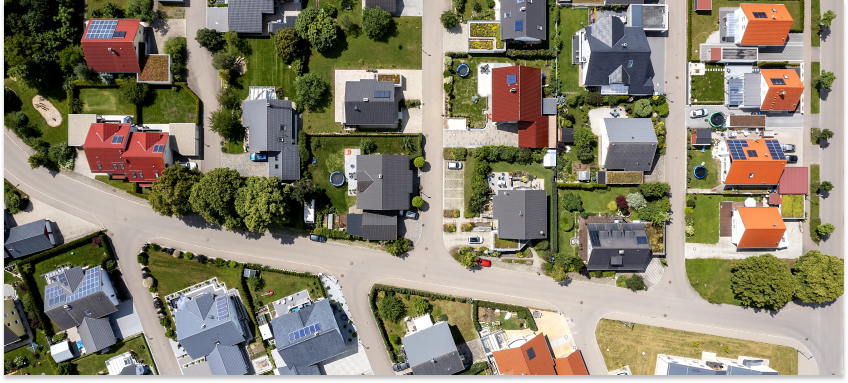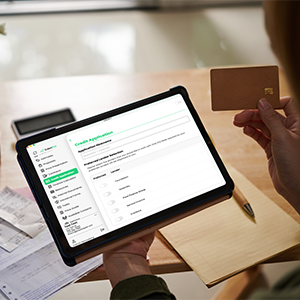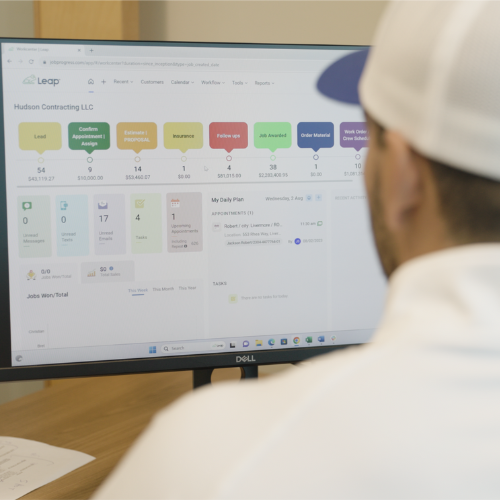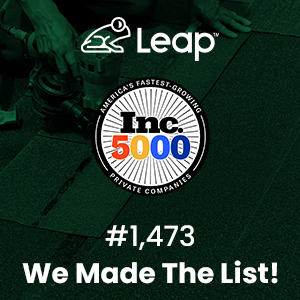Technology is transforming the roofing industry. In fact, roofers now rely heavily on various types of software to streamline their operations, enhance productivity, and improve sales and customer satisfaction. So, what software do roofers use to improve their business?
Let’s explore the different types of software that are helping roofing contractors increase their profits, automate their workflows, and drive growth. From CRM solutions to specific tools and in-home sales, there’s a wide range of platforms built specifically for roofers.

What Software Do Roofers Use Each Day?
The roofing industry has seen significant technological advancements in recent years. Overall, software solutions have become integral to daily operations. They help roofers manage customer relationships, streamline sales processes, take precise measurements, create accurate imaging, and handle payments and financing efficiently.
These tools have revolutionized how roofers work, saving time and money while improving accuracy and customer satisfaction. And roofing software encompasses a wide range of applications. For example, the most common software solutions that roofers use include:
- Customer Relationship Management (CRM) Software
- In-Home Sales Software
- Measurement Tools
- Imaging Technology Platforms
- Payments and Financing Solutions
CRM software helps roofers manage every step of their operations. Sales software, however, streamlines the sales process when you meet with homeowners at the kitchen table.
Measurement tools ensure precise roof measurements, reducing material waste and errors. And imaging technology allows for detailed roof inspections and visualizations, which aid in planning and customer presentations. Finally, payments and financing software simplify financial transactions and offer flexible payment options to customers.
Each of these software types addresses specific needs within the roofing industry. Together, they create a comprehensive digital toolkit that enhances efficiency and effectiveness. Therefore, let’s dive deeper into each type of roofing software and understand how they contribute to the industry’s transformation.
1. CRM Software
Roofing CRM software is a cornerstone of modern roofing businesses. It helps roofers manage customer interactions, track leads, and maintain records. And with Leap, you can also manage every project from the initial appointment to the installation and job completion.
With Leap, every stage of your workflow is covered. You can manage your leads, schedule appointments, create estimates, sign contracts, and manage your production workflow. Better yet, you can create invaluable custom reports to analyze sales performance, future income, job financials, and more.
You can easily store and access customer information, such as contact details, project history, and communication logs. Specifically, the customer data isn’t only for you. You can also provide a portal for customers with everything they need to know about their job.
Leap automates many routine tasks. For example, it can schedule follow-up calls and send appointment reminders. In general, these automation features save time and reduce administrative burdens. You can focus more on building relationships and doing great work instead of endless paperwork.
Leap prides itself as one of the best CRM solutions for residential contractors. You can analyze customer data to identify trends, track sales performance, and manage your production. Project management capabilities span from work orders and materials to crew scheduling and subcontractor management. Additionally, Leap integrates with other tools to create a seamless workflow.
Overall, CRM software is essential for roofers who want to improve customer satisfaction and drive business growth. It provides a comprehensive solution for managing customer relationships, streamlining operations, and gaining actionable insights.
2. Sales Software
Sales software is vital for roofing sales reps aiming to improve their closing rates and widen their margins while working with homeowners to close more deals. And as a result, this type of software streamlines the entire sales cycle. With Leap’s in-home sales app, SalesPro, you can efficiently manage your sales pipeline, ensuring no opportunity slips through the cracks.
SalesPro empowers sales reps as they meet with homeowners at the kitchen table. You can quickly generate precise estimates and turn them into contracts in just a few clicks. Moreover, you can sign contracts directly within the app and collect payments. You can even offer financing through our lending integrations and receive credit approvals in seconds.
Through SalesPro, you gain pricing control like never before. If you utilize these guardrails, then your sales reps can never undersell a job or offer products that are out of stock or no longer available. You can manage discounts and promotions as well.
This one-of-a-kind sales software eliminates irrelevant sales tasks and automates everything else. And better yet, you can enhance your presentations and build a library of brand collateral and case studies through the SalesPro resource center.
3. Measurement Tools
Accurate measurements are critical in roofing projects. In fact, incorrect data can cause project delays, cost overruns, or lost jobs altogether.
Measurement tools provide you with precise measurements of roofs, ensuring accurate estimates and reducing material waste. These tools use advanced technology, such as aerial imagery and 3D modeling to capture roof dimensions.
Another type of measurement tool is satellite imagery software. This software uses satellite images to measure roof dimensions and generate reports. It’s especially useful for large-scale projects or when drone access is limited. Satellite imagery provides a quick and efficient way to gather roof measurements, allowing roofers to create accurate estimates without visiting the site.
Luckily, Leap integrates with many of the industry’s leading measurement tools, such as EagleView, GAF QuickMeasure, Scope Technologies, and Hover. These tools work seamlessly with both Leap and SalesPro to round out your tech stack.
4. Imaging Technology
Imaging technology has transformed the way roofers inspect and present roofing projects. This software uses advanced imaging techniques, such as high-resolution photos, thermal imaging, and 3D visualizations to provide detailed views of roofs. In addition, these images help roofers identify issues, plan repairs, and communicate effectively with customers.
High-resolution photos are a fundamental aspect of imaging technology. Roofers can capture detailed images of roofs using drones or cameras. These photos reveal defects, damage, and areas that need repair.
You can then use these images to create comprehensive inspection reports and share them with customers. This visual evidence helps homeowners understand the condition of their roofs and the necessary repairs.
Leap partners with CompanyCam to increase the precision and effectiveness of roof inspections, measurements, and presentations through photos. It provides your business with powerful tools to identify issues, plan projects, and communicate clearly with customers.
5. Payment Systems and Financing Tools
Managing payments and financing is a crucial aspect of any roofing business. And there’s software that simplifies this process, offering flexible payment options and streamlined payment processing. This type of software enhances financial management and gives customers more flexibility.
You can accept payments through various methods, such as credit cards and ACH transfers. This convenience benefits both the roofing business and the homeowner. Customers can choose their preferred payment method, making the payment process hassle-free. Your business, on the other hand, can receive payments faster and reduce the risk of delayed payments.
Financing options are another significant advantage. This flexibility makes it easier for homeowners to afford roofing services, leading to higher sales and customer satisfaction.
Thankfully, Leap offers these features directly within our software as we understand it’s essential for your sales. With LeapPay, you can generate invoices, improve your cash flow, track financials, and collect payments faster than ever before. And LeapPay transaction fees are some of the lowest in the industry.
Benefits of Software for Roofers
So, what software do roofers use each day? The reality is that an effective roofing business will use a variety of solutions to maximize their efforts and craftsmanship. In general, this is the best way to create business sustainability and scale without overwhelming your staff.
The adoption of software offers numerous benefits. One of the most significant advantages is increased efficiency. Automation alone can streamline numerous tasks, saving your team time and saving your business money.
Software also enhances accuracy in your operations. Measurement tools and imaging technology provide precise data, reducing the likelihood of mistakes in estimates and project planning. And accurate data ensures that roofers order the right amount of materials to minimize waste and cost overruns. This precision leads to more successful projects and higher satisfaction.
Another key benefit is improved communication. CRM and sales software facilitate seamless communication between all project stakeholders. You can keep customers informed about project progress, send updates, and address any concerns promptly. This transparency builds trust and enhances the overall customer experience.
Lastly, financial management is another area where software excels. You can simplify financial transactions and offer flexible payment options. Additionally, software provides valuable insights into financial performance. Now, you can make informed decisions, plan for the future, and get paid on time!
Overall, software offers roofing businesses a competitive edge. These benefits lead to increased efficiency, reduced costs, and a more professional experience for customers.
Implementing Software in Your Roofing Business
Implementing software in a roofing business involves several steps. The first step is to identify the specific needs of your business. Determine which areas of your operations could benefit from automation and improved efficiency.
Once you have identified your needs, research different software options. Look for software that offers the features and capabilities that match your requirements. Consider factors such as ease of use, integration with existing tools, and customer support. It’s essential to choose software that fits seamlessly into your workflow and is user-friendly for your team.
After selecting the right software, plan the implementation process. This involves setting up the software, migrating existing data, and training your team. Ensure that all team members are familiar with the new tools and understand how to use them effectively. Training is crucial to ensure a smooth transition and maximize the benefits of the software.
During the implementation phase, it’s important to monitor progress and address any issues that arise with the provider. Regularly evaluate the software’s performance and gather feedback from your team. This helps identify any areas that need improvement and ensures that the software is meeting your business needs.
Implementing software may require an initial investment of time and resources. However, the long-term benefits far outweigh the costs.
Eliminate the Painful Process with Leap
Your path to sales success and sustainability starts with Leap. It’s the complete platform for the professional contractor. From your CRM needs and project management to in-home sales and documentation, Leap has the software solutions to meet your ever-growing needs.
And with Leap, you don’t have to ditch the tools you know and love. Leap integrates directly into your workflow so that you don’t lose any of the functionality and systems you have in place.
Investing in Leap for your roofing business is a strategic decision that can drive growth and success. Leap provides the end-to-end job management and CRM tools to strengthen your daily workflow. And SalesPro is available as a standalone tool or add-on to give your sales reps as boost.
Leap helps you manage more all in one place, from your leads and estimates to project management and communications. For more information, you can compare our products to find the right fit for your business.
So, are you ready to supercharge your sales, win more jobs, and manage each project more efficiently? If so, fill out the form below and schedule a quick demo with one of our software experts.
You now know what software roofers use to grow their businesses. And you don’t want to fall behind your competition. Discover the power of Leap and eliminate the painful manual processes that undermine the great work you do.




